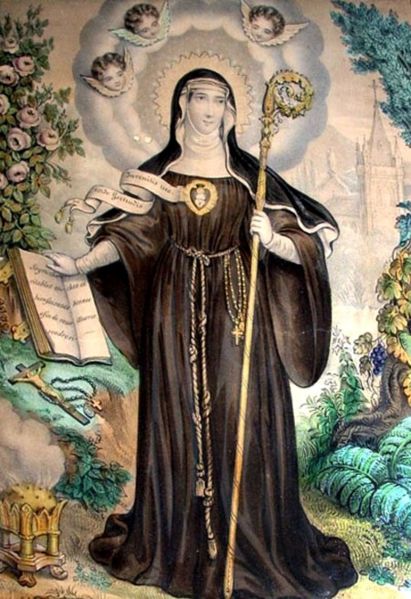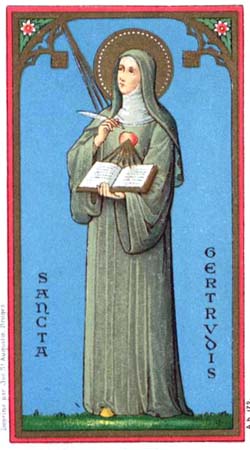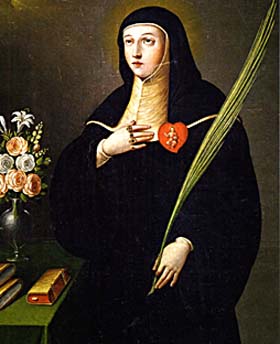St. Gertrude the Great
Saint, Benedictine and mystic writer; born in Germany, January 6, 1256; died at Helfta, near Eisleben, Saxony, November 17, 1301 or 1302.
Nothing is known of her family, not even the name of her parents. It is clear from her life (Legatus, lib. I, xvi) that she was not born in the neighborhood of Eisleben. When she was but five years of age she entered the alumnate of Helfta. The monastery was at that time governed by the saintly and enlightened Abbess Gertrude of Hackeborn, under whose rule it prospered exceedingly, both in monastic observance and in that intellectual activity which St. Lioba and her Anglo-Saxon nuns had transmitted to their foundations in Germany. All that could aid to sanctity, or favor contemplation and learning, was to be found in this hallowed spot. Here, too, as the center of all its activity and the impetus of its life, the work of works—the Opus Dei, as St. Benedict terms the Divine Office—was solemnly carried out. Such was Helfta when its portals opened to receive the child destined to be its brightest glory. Gertrude was confided to the care of St. Mechtilde, mistress of the alumnate and sister of the Abbess Gertrude. From the first she had the gift of winning hearts, and her biographer gives many details of her exceptional charms, which matured with advancing years. Thus early had been formed between Gertrude and Mechtilde the bond of an intimacy which deepened and strengthened with time, and gave the latter saint a preponderating influence over the former.
Partly in the alumnate, partly in the community, Gertrude had devoted herself to study with the greatest ardor. In her twenty-sixth year there was granted her the first of that series of visions of which the wonderful sequence ended only with life. She now gauged in its fullest extent the void of which she had been keenly sensible for some time past, and with this awakening came the realization of the utter emptiness of all transitory things. With characteristic ardor she cultivated the highest spirituality, and, to quote her biographer, “from being a grammarian became a theologian”, abandoning profane studies for the Scriptures, patristic writings, and treatises on theology. To these she brought the same earnestness which had characterized her former studies, and with indefatigable zeal copied, translated, and wrote for the spiritual benefit of others. Although Gertrude vehemently condemns herself for past negligence (Legatus, II, ii), still to understand her words correctly we must remember that they express the indignant self-condemnation of a soul called to the highest sanctity. Doubtless her inordinate love of study had proved a hindrance alike to contemplation and interior recollection, yet it had none the less surely safeguarded her from more serious and grievous failings. Her struggle lay in the conquest of a sensitive and impetuous nature. In St. Gertrude’s life there are no abrupt phases, no sudden conversion from sin to holiness. She passed from innocence to sanctity almost unconsciously, and as naturally as she had passed from the alumnate to the community. Outwardly her life was that of the simple Benedictine nun, of which she stands forth preeminently as the type. Her boundless charity embraced rich and poor, learned and simple, the monarch on his throne and the peasant in the field; it was manifested in tender sympathy towards the souls in purgatory, in a great yearning for the conversion of sinners, and in a vehement zeal for the perfection of souls consecrated to God. Her humility was so profound that she wondered how the earth could support so sinful a creature as herself. Her raptures were frequent and so absorbed her faculties as to render her insensible to what passed around her. She therefore begged, for the sake of others, that there might be no outward manifestations of the spiritual wonders with which her life was filled. She had the gift of miracles as well as that of prophecy.
When the call came for her spirit to leave the worn and pain-stricken body, Gertrude was in her forty-fifth or forty-sixth year, and had in turn assisted at the deathbed and mourned for the loss of the holy Sister Mechtilde (1281), her illustrious Abbess Gertrude of Hackeborn (1291), and her chosen guide and confidante, St. Mechtilde (1298). When the community was transferred in 1346 to the monastery of New Helfta, the present Trud-Kloster, within the walls of Eisleben, they still retained possession of their old home, where doubtless the bodies of St. Gertrude and St. Mechtilde still lie buried, though their place of sepulture remains unknown. There is, at least, no record of their translation. Old Helfta is now crown-property, while New Helfta has lately passed into the hands of the local municipality. It was not till 1677 that the name of Gertrude was inscribed in the Roman Martyrology and her feast was extended to the universal Church, which now keeps it on November 15, although it was at first fixed for November 17, the day of her death, on which it is still celebrated by her own order. In compliance with a petition from the King of Spain she was declared Patroness of the West Indies; in Peru her feast is celebrated with great pomp, and in New Mexico a town was built in her honor and bears her name. Some writers of recent times have considered that St. Gertrude was a Cistercian, but a careful and impartial examination of the evidence at present available does not justify this conclusion. It is well known that the Cistercian Reform left its mark on many houses not affiliated to the order, and the fact that Helfta was founded during the “golden age” of Citeaux (1134-1342) is sufficient to account for this impression.
 Many of the writings of St. Gertrude have unfortunately perished. Those now extant are:—(I) The “Legatus Divinae Pietatis“; (2) The “Exercises of St. Gertrude”; (3) The “Liber Specialis Grati” of St. Mechtilde. The works of St. Gertrude were all written in Latin, which she used with facility and grace. The “Legatus Divinae Pietatis” (Herald of Divine Love) comprises five books containing the life of St. Gertrude, and recording many of the favors granted her by God. Bk. II alone is the work of the saint, the rest being compiled by members of the Helfta community. In the “Exercises” we have the saint at her best. They were written for her Sisters in religion, and we feel she has here a free hand unhampered by the deep humility which made it so repugnant for her to disclose favors personal to herself. The “Exercises”, which are seven in number, embrace the work of the purification and sanctification of the soul from the reception of baptismal grace to the preparation for death. Her glowing language deeply impregnated with the liturgy and Scriptures exalts the soul imperceptibly to the heights of contemplation. When the “Legatus Divinae Pietatis” is compared with the “Liber Specialis Gratiae” of St. Mechtilde, it is evident that Gertrude is the chief, if not the only, author of the latter book. Her writings are also colored by the glowing richness of that Teutonic genius which found its most congenial expression in symbolism and allegory. The spirit of St. Gertrude, which is marked by freedom, breadth, and vigor, is based on the Rule of St. Benedict. Her mysticism is that of all the great contemplative workers of the Benedictine Order from St. Gregory to Blosius. Hers, in a word, is that ancient Benedictine spirituality which is simply the spirit of the Church and which Father Faber has so well depicted (All for Jesus, viii).
Many of the writings of St. Gertrude have unfortunately perished. Those now extant are:—(I) The “Legatus Divinae Pietatis“; (2) The “Exercises of St. Gertrude”; (3) The “Liber Specialis Grati” of St. Mechtilde. The works of St. Gertrude were all written in Latin, which she used with facility and grace. The “Legatus Divinae Pietatis” (Herald of Divine Love) comprises five books containing the life of St. Gertrude, and recording many of the favors granted her by God. Bk. II alone is the work of the saint, the rest being compiled by members of the Helfta community. In the “Exercises” we have the saint at her best. They were written for her Sisters in religion, and we feel she has here a free hand unhampered by the deep humility which made it so repugnant for her to disclose favors personal to herself. The “Exercises”, which are seven in number, embrace the work of the purification and sanctification of the soul from the reception of baptismal grace to the preparation for death. Her glowing language deeply impregnated with the liturgy and Scriptures exalts the soul imperceptibly to the heights of contemplation. When the “Legatus Divinae Pietatis” is compared with the “Liber Specialis Gratiae” of St. Mechtilde, it is evident that Gertrude is the chief, if not the only, author of the latter book. Her writings are also colored by the glowing richness of that Teutonic genius which found its most congenial expression in symbolism and allegory. The spirit of St. Gertrude, which is marked by freedom, breadth, and vigor, is based on the Rule of St. Benedict. Her mysticism is that of all the great contemplative workers of the Benedictine Order from St. Gregory to Blosius. Hers, in a word, is that ancient Benedictine spirituality which is simply the spirit of the Church and which Father Faber has so well depicted (All for Jesus, viii).
The characteristic of St. Gertrude’s piety is her devotion to the Sacred Heart, the symbol of that immense charity which urged the Word to take flesh, to institute the Holy Eucharist, to take on Himself our sins, and, dying on the Cross, to offer Himself as a victim and a sacrifice to the Eternal Father (Congregation of Rites, April 3, 1825). Faithful to the mission entrusted to them, the superiors of Helfta appointed renowned theologians, chosen from the Dominican and Franciscan friars, to examine the works of the saint. These approved and commended them throughout. In the sixteenth century Lanspergius and Blosius propagated her writings. The former, who with his confrere Loher spared no pains in editing her works, also wrote a preface to them. The writings were warmly received especially in Spain, and among the long list of holy and learned authorities who used and recommended her works may be mentioned: St. Teresa, who chose her as her model and guide, Yepez, the illustrious Suarez, the Discalced Carmelite Friars of France, St. Francis de Sales, M. Olier, Fr. Faber, Dom Gueranger. The Church has inserted the name of Gertrude in the Roman Martyrology with this eulogy: “On the 17th of November, in Germany (the Feast) of St. Gertrude Virgin, of the Order of St. Benedict, who was illustrious for the gift of revelations.”
Gertrude Casanova (Catholic Encyclopedia)







